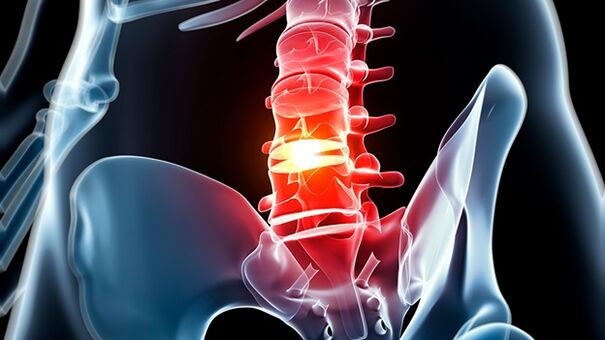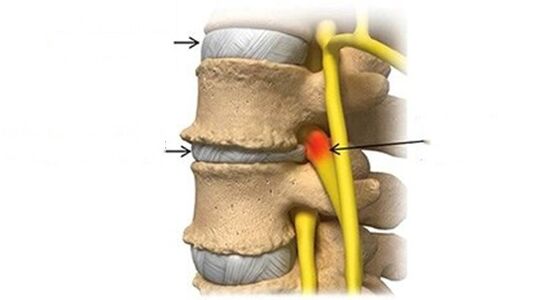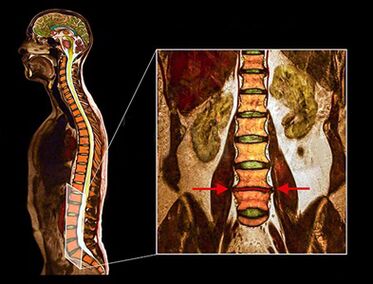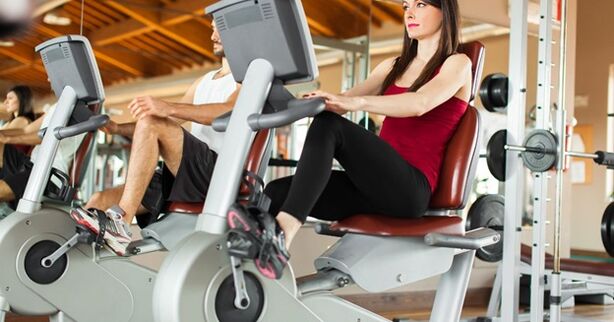Osteochondrosis (Degenerative disk disks) in the lumbar spine or lower back is a consequence of invisible disk changes, which leads to lower back pain.
Intervertebral discs are hard, fibrous structures that act as ligaments between vertebral, absorb moves and provide the absorption of the shock of the spine.The discs are elastic, but strong enough to facilitate movements, such as body slope, forward, forward or on the sides.
Despite the name, Osteochondrosis is not considered true with disease and symptoms over time, it is generally not worse.Discs, as well as all body structures, degraded and degeneration disk develop in all people, as part of an involutionary process.
The characteristic characteristic of osteochondrose is a gradual reduction of symptoms because the spine begins to stabilize.Treatment of osteochondrose of the lumbar spine is focused on minimizing pain, stabilization of spine and improvement or maintenance of mobility.
Symptoms

Most cases of the manifestation of osteochondrose lumbar spine has a lightweight, permanent back pain, which occasionally enhances several days or more.
Symptoms can vary, but the most proficiency includes:
- Moderate, permanent pain in the lower back.The pain in the damaged disk is the most common symptom of disk degeneration.The pain can be extended to buttocks, groin and upper thighs.This pain usually feels like stupid, and the intensity can vary from light to heavy.
- Periodic acute episodes of pain.The pain in the back can be intensified for several days or weeks and then return to a more moderate level.The outbreak of pain occurs as degeneration and lubricated as the spine is gradually stabilized.Pain choices can occur at once and pain manifestations often lead to mobility reduction.
- Local pain.The lower part of the rear of the surrounding disk environment can be sensitive to touch.Local pain is caused by inflammation and muscular tension in the area of Degeneration Degeneration.
- A knife pain.Neurological symptoms, including numbness, weakness, or sharp, shooting pain in buttocks, hips and / or back of the leg, can be felt if the disk height is significantly reduced, and conditions for compression of nerve roots.The pain in legs with osteochondrose of the lumbar spine usually does not fall below the knee.
- A sense of sudden weakness or instability can occur with significant disk and patient weakening, it creates that the lower back is incomplete performing their functions.
In addition, pain can be intensified or decreased when performing some movements or certain pose, such as:
- The pain in the seat.Sitting over long periods often causes increased lower back pain and stiffness and decreases after the formation or change of position.
- Strengthening pain by tilting or rotation.The twist and slope forward, back or side may cause intensive, damaged disk pains.
- Reducing pain when walking or changing positions.When the spine changes position, pressure on discs decreases or redistribution from discs to muscles and joints.Frequent positions, alternating standing and sitting, as well as short walks can help reduce stiffness and minimizing pain.
Degeneration disk should not cause symptoms of intestinal dysfunction / bladder, fever with pain in the back, inexplicable and faster weight loss or intense abdominal pain.These symptoms indicate more serious conditions and often require operational methods of treatment.
Associated symptoms
With osteochondrose of the lumbar spine, in addition to lower back pain, other symptoms associated with disk degeneration can occur.For example:
- Proteins inside the disc may cause significant inflammation if they come into contact with the surrounding clinical structures, and this inflammation can lead to lower back cramps, as well as radial pain, with the back of the lower extremities (also called Ishias).
- The degeneration of the lumbar disk can contribute to the development of lumbar stenosis and / or lumbar osteoarthritis, as well as other terms in the lower back.
- The degenerate disk can also lead to the appearance of a lumbar intervertebral disk.Neurological symptoms with the disk kilina can be acute and intense.
- Symptoms caused by disk degeneration in lumbar spines can be widely varyed depending on how fast or completely disk has suffered degeneration and affecting the surrounding spinal structures.
- Osteochondrose pain is usually caused by the deformation of muscles that support spine and inflammation around the structures near the disk.
Causes of osteochondrose of the lumbar spine
Osteochondrosis appears due to age wear and disruption of the disk structure, and the degeneration process can accelerate due to injury, general condition, health and lifestyle, and perhaps genetic predisposition to the development of pathological processes.

Osteochondrosis rarely begins serious injuries, such as a car accident.It is more likely that the initiation of degenerative processes is associated with low-brown injury.
Pain Law related to lumbar osteohondrose usually generates one or more pathological processes:
- Inflammation, disk proteins are irritated to the surrounding nerves - and small nerves on the disk itself and potentially large nerves that go to their feet.
- Abnormal unsteadiness Micro, when the outer rings of the disk, call the fibrous ring, exhausts and cannot effectively absorb electrical vectors on the spine, which leads to the movement along the vertain segment.
- Long time, the pain in the osteochondrose of the lumbar spine is ultimately decreasing, not worsen.This pain relief occurs because the disk completely damaged by degeneration no longer has any inflammatory protein (which can cause sleep) and sleep disk passes into a stable position, eliminating micro movements that cause pain.
Risk factors
Life factors that affect the general state of health can affect intervebrelal disks.Risk factors from degenerative disk disease (osteochondrose) include:
- Family history of back pain or skeletal and muscle disorders
- Excessive load at the bottom of the back, due to the dealing with sports or nature of the work
- Long static loads on discs due to the extended seat and / or bad posture
- Lack of disk support due to weak back muscles
- Obesity
- Smoking or any form of nicotine consumption
Degeneration of the disk is part of the body aging, but not all people developed pain or any special symptoms.Symptoms usually occur in the event of instability, muscle tension and, possible, irritation of the nerve root.
Diagnostics
- The history of the disease includes a detailed study of symptoms in the patient, their intensity and relationship with the loads or position of the body.Information on regular physical activity, idle habits and past injuries are also needed.
- Physical examination is necessary to study the range of movements and the state of the muscle corset.The presence of painful areas on palpation or physical irregularities is also determined.In addition, neurological tests are carried out that would determine the neurological deficit.
- The above diagnostic methods are usually sufficient to diagnose osteochondrose, but the correct diagnosis requires the use of visualization methods.
- CT
- Radiography
- Msct
- Pat
- MRI - This diagnostic method allows you to clarify degeneration, the presence of fractures, hernie of disk stenosis.Often the MRI study is needed in preparation for surgical treatment to determine the location of the degenerate disk correctly and planned work.

Studies have shown that the results of MRIs with moderate or significant degeneration of discs are in the scan of patients, both with strong pain and minimum or lack of pain.In addition, many painful conditions cannot occur at MRI.For this reason, the diagnosis cannot be performed exclusively on the basis of visualization results, and the diagnosis is possible only based on the totality of all clinical and instrumental test methods.
Treatment
The initial methods of treatment of osteochondrose lumbar mother manifestation and pain usually include the following combinations:
- Excessive pain block They can reduce inflammation, which contributes to discomfort, stiffness and irritation of nervous roots.
- On a prescription with painkillers.In strong pain, muscle relaxants or narcotic painkillers can be prescribed.These medications are usually used to treat intense, acute pain, which is expected to last more than a few days or weeks.These drugs can cause dependence and cause serious side effects, so they should be used with caution.
- Heat and ice.The use of heat in the lower back improves blood circulation, which reduces muscle cramps and tension and improves mobility.LED packages can reduce inflammation and mitigate moderate pain.It is useful to use heat before physical muscle relaxation exercises and use LED after physical activity to reduce inflammation.
- Hand therapy. Manipulation What is the specialist implemented is a popular method of control pain in the lower back pain.Exercising doctors, hand therapists, use hands to influence different area areas to reduce tension in muscles and joints.It was found that manipulations are an effective measure for temporary pain, and in some cases it is effective as drug therapy.
- Massage.Exposure to massage methods can reduce tension and cramps in lower back muscles, reduce pressure on the spine and relieve pain.In addition, the therapeutic massage can improve blood circulation, ensuring the delivery of nutrients and oxygen for tense muscles.
- Epidural injections of steroids.The introduction of steroids in the space surrounding the spine can reduce pain pulses as well as inflammation.Steroid injection can be used in combination with the physical therapy program to relieve pain during physical exercises and rehabilitation.As a rule, the epidural steroid injection enables pain reduction in a period of several weeks to one year.
In many cases for effective anesthesia, a combination of treatment methods.The trial and error process is generally necessary to select the treatment that turns out to be most efficient.
A long bed is not recommended, and as a rule, the possibility of immobilization is possible with strong pain for a short time, because the lack of physical activity can lead to the weakening of the muscles and normal spine support.
Practice Therapy and Activity Modification

Physical exercises are needed to maintain healthy spine mobility.The effective lumbar spine exercise program should include:
- Stretching exercises for lower back muscles, hips and pelvis, as well as muscle damage.Tightening these muscles increases the pressure on the lumbar spine and contributes to the development of pain in the lower back.
- Strengthening the lower back and abdominal muscles helps you maintain good posture and better support the spine.Muscle exercise program may include an individual exercise program, dynamic stabilization of spine, Tai Chi, Pilates or others.
- Aerobic exercise with low impacts, which increases heart rate, improves blood circulation and nutrients and oxygen necessary to repair body tissue repair.For example, it could be walking, swimming and water for water.
Exercise programs are usually adapted for each case, depending on the overall health, weight of pain and personal preferences.
In addition, small adjustments to daily activities (lifestyle modifications) can effectively alleviate pain.For example, carrying a bra while lifting heavy objects or avoiding twisting when lifting heavy objects can prevent increased pain due to excessive stress on discs.Using an ergonomic chair and orthopedic mattress can also improve your posture and reduce stress on discs.
Surgical treatment
The surgical treatment of osteochondrose of the lumbar spine is necessary in cases where conservative treatment in 6 months was inefficient.Surgical treatment for osteochondrose is always selective, which means that the patient I decides whether to undergo surgery or not.
It is recommended to take into account all factors before deciding on the substrate of Osteochondrose surgery, including the length of the recovery period, pain management during recovery and rehabilitation of the spine.
Connecting vertebrae
Standard surgical treatment of osteochondrose of the lumbar spine is the operation of the merger in which two vertebrates are spent together.The purpose of joining (spondylodes) is to reduce pain and removal of instability in the body segment of the spine.
All fusion operations of spine are as follows:
- The damaged disk is completely removed from the intervertebral space (discoctomy).
- Stabilization is performed using bone transplantation and / or tools (implants, plates, bars and / or screws).
- Then the fuse of the vertebrae, forming a firm, motionless structure.Fights happen within a few months after the proceedings, not during the proceedings.
After surgery, he is prescribed in the corset, taking analgesics.Exercises are very carefully related, taking into account the individual characteristics of the patient and the degree of tissue regeneration.Full recovery after connecting can take up to a year until the vertebrae grows together.
Surgical substitute for an artificial disk
The replacement of the damaged disk with an artificial implant was developed in recent years as an alternative to the merger.The work for replacing the disk consists completely by removing the disk damaged by degeneration (discoctomy), restoring disk space to the natural height and artificial disk implantation.
This procedure is designed to maintain the movement in spine similar to natural movements, reducing the likelihood of increasing pressure on neighboring spinal segments (a fairly common complication of spinal fusion).
Recovery after disk replacement operation usually takes up to 6 months.






















